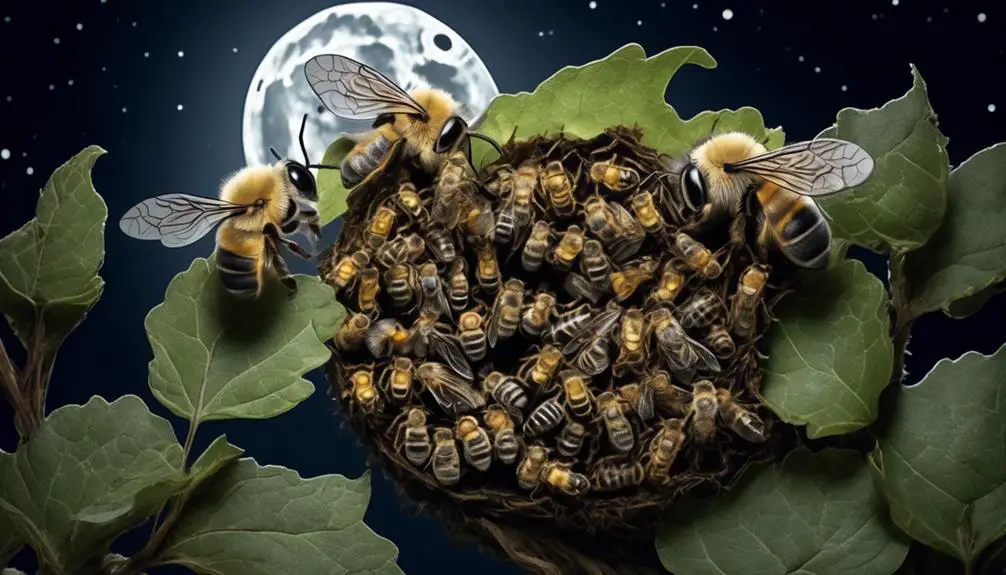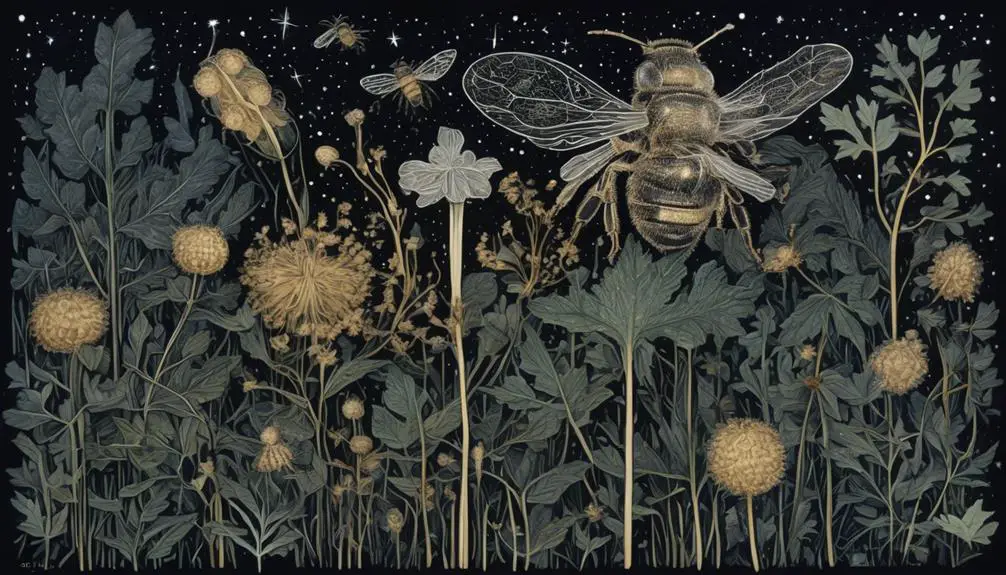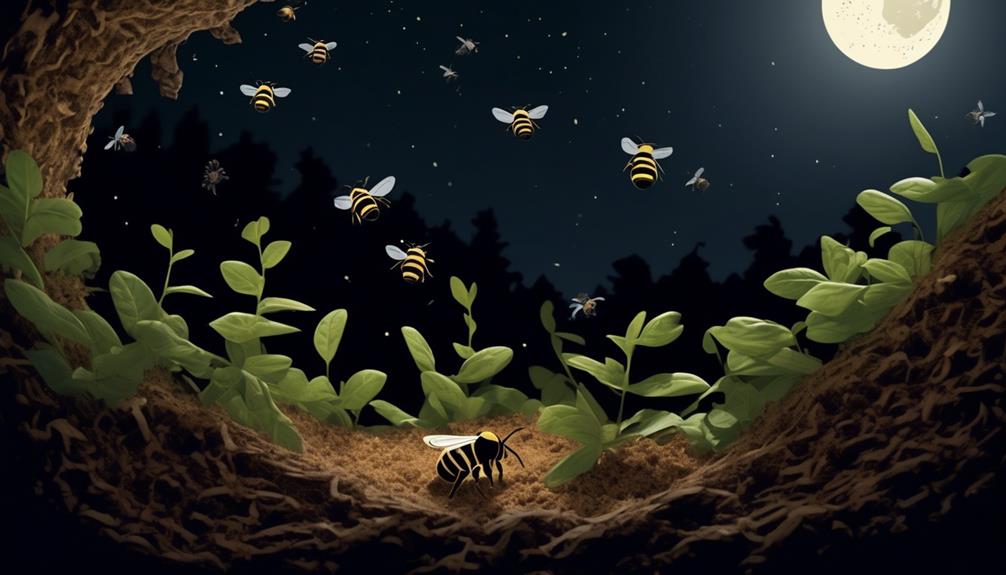Keep reading to unveil the fascinating, nocturnal world of leaf cutter bees and their secret sleeping spots.

Where Do Leaf Cutter Bees Sleep at Night
Just as a star shines brightest in the quiet of the night, leaf cutter bees, too, have their secrets hidden in the darkness.
You've likely seen these industrious creatures, tirelessly going about their work in the daytime, but have you ever wondered where they go when the sun sets?
Their nocturnal nesting habits are as intriguing as they are elusive, offering a fascinating insight into the world of these miniature architects.
But to fully appreciate this, you'll need to journey into the night with us, venturing into the unknown, to uncover the resting places of these tiny creatures.
Key Takeaways
- Leaf cutter bees sleep in leafy nests they create themselves, which provide protection and comfort for their offspring.
- They exhibit a state of torpor, similar to hibernation, during the night.
- Leaf cutter bees often choose to sleep in plants, clinging to plant stems, possibly to avoid predators and competition.
- Their unique sleeping habits, including huddling together for warmth and intermittently waking up for grooming and waste elimination, contribute to their adaptability and resilience.
Understanding Leaf Cutter Bees

To comprehend leaf cutter bees, you need to delve into their unique behavioral patterns, notably their sleeping habits, which significantly differentiate them from other bee species. Unlike their honey-producing counterparts, these solitary bees don't sleep in hives. Instead, they find refuge in leafy nests, often in holes they've gnawed out themselves.
Let's dissect their nocturnal routine. As dusk settles, they'll retreat into their nests, aligning themselves parallel to their leafy abodes. Remarkably, they don't just sleep; they go into a state akin to hibernation, called torpor. This state of lowered physiological activity reduces their metabolic rate and conserves energy during the cooler night hours.
You might wonder about their exposure to threats. However, leaf cutter bees have evolved distinct protective mechanisms. Their nests often have multiple chambers, each with a single egg. This layout confuses predators, increasing the survival rate of their offspring.
In essence, understanding the leaf cutter bees' unique sleeping habits provides valuable insights into their survival strategies. This is a testament to their adaptability and resilience, traits that are crucial in the face of environmental changes. Comprehending these behaviors can help us devise effective conservation strategies.
Habitats of Leaf Cutter Bees

Diving into the habitats of leaf cutter bees, you'll find them inhabiting a variety of ecosystems, from forests to deserts, always adapting their nesting behavior to suit their surroundings. They're not picky about where they set up shop, and you'll often find them in your garden, making use of the plants you've so lovingly nurtured.
They prefer to nest in pre-existing cavities in dead wood or hollow stems, where they'll cut circular pieces of leaf to line and partition their nests. However, they're just as happy to take advantage of human-made structures, such as holes in walls or even the tubing of your garden hose.
It's worth noting that while leaf cutter bees are solitary creatures, they're not antisocial. You may often find several nesting close together, forming a loosely organized community. And don't worry, these insects don't sting unless severely provoked, making them harmless to humans.
Nocturnal Behavior of Leaf Bees

After observing their nesting habits during the day, you might be curious about what leaf cutter bees do when the sun goes down. Unlike some other bee species, leaf cutter bees tend to be diurnal, meaning they're active during the day and rest at night.
Their nighttime behavior is largely characterized by inactivity, as they retreat to their nests to rest and conserve energy for the following day. It's during this time that they'll often huddle together within their nests, using their bodies to maintain warmth, particularly in colder climates. This is a crucial strategy, as maintaining a steady body temperature is essential for their survival and productivity.
During the night, leaf cutter bees don't forage or cut leaves. Any leaf cutting activity observed after dusk is likely due to an overcast day or a particularly shaded nesting area, rather than a nocturnal habit. This behavior aligns with their main predators' habits, as many are also day-active creatures. Therefore, resting during the night also serves as a natural defense mechanism, reducing their exposure to potential threats.
In essence, leaf cutter bees' nights are about survival, rest, and preparation for the next day's activities.
Nesting Patterns and Sleep Sites

Let's delve deeper into the intricate details of leaf cutter bees' nesting patterns and the specific sites they choose for their sleep.
Leaf cutter bees exhibit a fascinating nesting behavior. They're solitary creatures, meaning they don't live in hives like honey bees. Instead, they nest in pre-existing holes in wood or in the ground, often in close proximity to one another. They're quite resourceful and will use whatever's available, from hollow stems to man-made structures.
Each bee constructs a series of brood cells within her nest. She lines each cell with pieces of leaf that she's meticulously cut and carried back to her nest. This leafy lining serves as both a protective barrier for her offspring and a comfy bed.
At night, leaf cutter bees sleep inside these nests. They're not true hibernators, but they do enter a state of torpor, reducing their metabolic rate and conserving energy. It's a sleep-like state where they're less responsive to their environment.
Unusual Sleeping Habits Explained

You might find it intriguing that leaf cutter bees, despite their solitary nature, exhibit some unusual sleeping habits that are quite different from other bee species. Unlike honey bees that tend to sleep inside their hives, leaf cutter bees often choose to sleep in plants. They're particularly fond of clinging to plant stems, where they fold their antennae and tuck in their legs, entering a state of torpor, which is a kind of deep sleep.
Their sleep isn't continuous, though. Leaf cutter bees wake up intermittently for brief periods, presumably for grooming and waste elimination. Interestingly, they don't always return to the same sleeping spot, suggesting a lack of territoriality in their sleep sites.
Another striking aspect of their sleep behavior is their preference for daylight hours. Most bees are diurnal, active during the day and resting at night. However, leaf cutter bees can be seen active during nighttime, indicating a certain level of nocturnality. It's speculated that this adaptation might help them avoid predators and competition.
These variations in sleep patterns offer a fascinating insight into the adaptability and resilience of leaf cutter bees, further highlighting their uniqueness among the bee species.
Conclusion
So, you've learned that leaf cutter bees sleep in their nests at night, often in the very cells they've carved out in plant stems or wood. They're not nocturnal, preferring their rest when the sun goes down.
Their unusual sleeping habits, curled up inside their nests, might seem odd to us but it's perfectly normal for them. Understanding these patterns gives us insight into their behavior, helping us protect and respect these vital pollinators.


